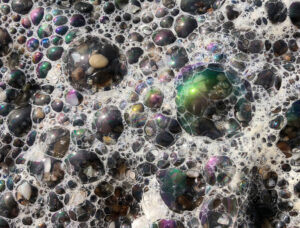It’s safe to say that most Californians harbor a soft spot for sea otters, our furry ocean friends who hold hands while napping and charmingly use tools to smash open tasty mollusks. So two bleak reports this past month concerning the fate of the southern sea otter were met with much dismay.
First, researchers in Monterey Bay announced they had documented the first otter mortalities from a toxin–microcystin–that comes from inland freshwater algal blooms.
Then, California’s Department of Fish and Game reported a dramatic increase in otter deaths from white shark bites throughout the southern end of the otters’ range.
These reports are hardly good news for a marine mammal population that has recovered from a mere 50 or so individuals in 1938 to a tenuous 2,711 today. Hunted for their thick pelts from 1741 to 1911, the sea otter’s recovery story has turned decidedly bittersweet as reintroduction efforts falter and populations fail to increase as much as scientists initially hoped.
But what do these two depressing studies really mean for the future of sea otters? Have we just seen a few bad years, or are we witnessing the beginnings of long-term downward trends?
As far as the shark attacks go, it’s far too early to tell. “There’s not a lot of info on sharks,” says Monterey Bay Aquarium’s Michelle Staedler. “It’s very hard to tell whether [the sharks’] numbers are increasing or if their food sources are decreasing.” The only certainty, it seems, is that fatal attacks on otters are on the rise. “In the ’80s we were seeing 5 percent of dead sea otters from shark bites,” she says. “Now that’s up to 15 percent.”
Whatever the cause, any action taken to curb these attacks will be tricky. “This is an issue conservationists are facing around the world,” says Melissa Miller, senior wildlife veterinarian and pathologist with Fish and Game, “where one protected species is causing problems for another.” Great whites have been protected in California’s waters since 1994, and sea otters are federally listed as threatened under the Endangered Species Act, making harassment of either animal illegal.
So for sharks, this is more an issue of wait and see.
“This is a pretty quick killer, We’ve seen this on land, but never in the ocean.”
But what’s the outlook for microcystin’s effect on otters? Miller has traced the toxin to blooms in stagnant waters high in nitrogen and phosphorous–two fertilizers heavily used in California agriculture and also present in domestic animal waste, whether pets or livestock. As these sources continue to increase, it appears so will the blooms.
“This is a pretty quick killer,” says Staedler. “We’ve seen this on land, but never in the ocean.” The toxin’s newfound ability to affect marine creatures only adds to the laundry list of land-sea pollutants adversely impacting sea otters, and it might explain some of the past deaths that, until now, have remained mysteries. “This is probably more of a newly recognized problem than it is a new problem,” says Miller.
Will more and more otters meet their demise due to microcystin? “The question is open as to whether this is getting worse,” Miller says, “only time will tell.”
In the face of so much uncertainty, it can be difficult to know what to do to ensure sea otters grace California’s waters for years to come. According to Miller and Staedler, the main tasks at hand are more research and continued monitoring.
California’s Water Resources Control Board has been helpful in ensuring that both happen, providing funding for work on microcystin throughout the state, and prioritizing research on potential mitigation strategies for freshwater systems known to harbor the toxin. But mitigation will be a daunting task, since potential culprits range from agricultural and urban runoff to an excess of animal waste in waterways. Throw a changing climate in the mix, and you end up with a seemingly intractable problem that also pushes a lot of political buttons.
Nevertheless, while the outlook is less than cheerful, it’s thankfully too early to begin drafting an otter eulogy. “I don’t think it’s that grim,” says Miller. California sea otters are resilient creatures; they’ve been to the edge of extinction and back. As more is learned about the shark attacks and microcystin, we can begin to take steps ensuring they never get that close again.

.jpg)



